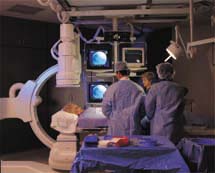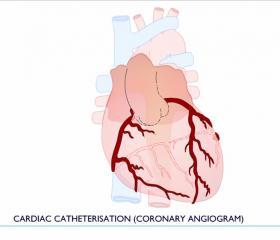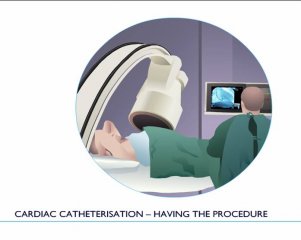Angiogram (Cardiac Catheter)

Cardiac Catheter Laboratory
What can an angiogram show?
An angiogram, sometimes called a cardiac catheter or coronary angiography shows any narrowings or bloackages in the coronary arteries. The coronary arteries supply the heart muscle with blood and oxygen, and narrowings may cause chest discomfort or pain (angina) and a blockage causes aheart attack (myocardial infarction).
An angiogram shows exactly where any narrowings in the coronary arteries are and how severe they are. Using this information a cardioloigst can determine whether the patient should be treated with medicines alone, angioplasty and stents (percutaneous intervention) or coronary artery bypass surgery.
It can also give information about the blood pressure inside the heart and how well the heart is pumping, as well as providing information about heart valve function.
How is an angiogram carried out?
The hospital will ask patients not to eat or drink anything for a few hours before the procedure. The test takes place in a procedure room similar to an operating theatre called a cardiac catheter laboratory. It usually takes about 30 minutes, but may take longer.
A catheter (a thin, flexible, hollow plastic tube) is passed into the artery in the groin or the wrist. Local anaesthetic is used to numb the area where the catheter is inserted. A general anaesthetic is not necesary, and usually there isonly mild discomfort at the beginning when the local anaesthetic is injected.
Using x-ray screening the catheter is directed through the arteries towards the heart. A special dye or cantrast is injected into the catheter and a series of x-ray movies are recorded. The contrast may briefly cause a hot, flushing sensation that lasts for a few minutes. The contrast shows the outline of blood flowing inside the coronoary arteries on the X-rays, and this shows any narrowings or blockages.
During the angiogram patients are continually linked to a heart monitor (ECG) that shows the heart rate and rhythm, and to a blood pressure monitor.
The angiogram is performed by a doctor, sometimes assisted by a nurse; a technician and radiographer make up the rest of the cath lab team.

Click the image above for an introduction to coronary angiography.
Please click the back button on your browser at the end of the animation to return to Private Cardiology.
What happens after an angiogram?
When the angiogramhas been completed the catheter is removed from the artery. There may be a little bleeding when the catheter is removed. A nurse or doctor will press on your groin for a short while or insert a small collagen plug to stop any bleeding. Patients must remain lying flat for a period after the angiogram.
Most people who have an angiogram without any additional procedures are able to go home the same day. However depending on the results and other conditions, the doctor mayask patientsto stay in hospital longer.
There may be a little bruising in the area where the catheter was inserted and this may remain tender for a few days. Patients usually feel completely back to normal within a few days. Patients are advised to avoid air travel for at least one week following an angiogram, but this advice may vary depending on the results or other medical conditions.
Are there any risks to having an angiogram?
An angiogram should be performed only on the advice of a heart specialist or cardiologist, and is the gold standard test for determining the coronary anatomy. The procedure does carry a very small risk of serious complications.
If there is bleeding from the place where the catheter was put in, occasionally it can leave a haematoma (where blood collects under the skin). This can feel uncomfortable and can cause bruising.
A coronary angiogram is a relatively safe test and serious complications are rare. The risk of having a heart attack, stroke or dying is estimated at less than1in1000 procedures. However the risk varies depending on your overall health and your individual heart condition.
A cardioloigst will not recommend that a coronary angiogram is performed unless he or she feels the benefits, in terms of determining a diagnosis or the severity of your condition, outweigh the small risk.
